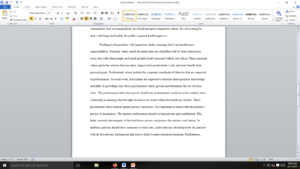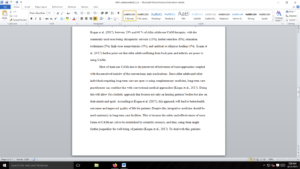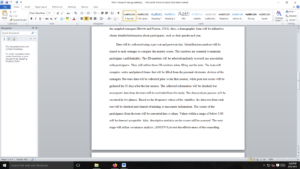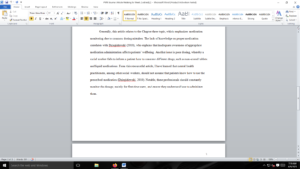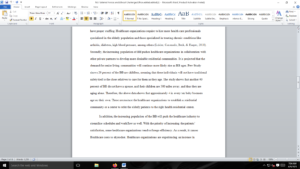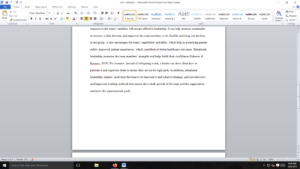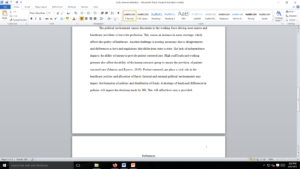Independence Medical Center is a rural referral hospital with 115 beds in Independence, Iowa. Like all hospitals, administrators and providers try to avoid errors, and it’s the patient safety officer’s role to monitor the hospital’s safety posture and recommend better practices. But what happens when a mistake leads to a medication error?
Patient Identification
At Independence Medical Center, the patient safety officer conducts daily safety rounds. Today, she’s rounding at the pediatric unit on the eighth floor.
Kyra Dilley and Virginia Anderson
Kyra Dilley: Hi, where’s the charge nurse?
Virginia Anderson: That’s me. What’s up?
Kyra Dilley: Well, I’m doing my safety rounds and I noticed that there are two patients on this floor in rooms directly across from each other: B. Moore and B.R. Moore.
Virginia Anderson: That’s not all — they have really similar birthdates! B. Moore was born on 8/11/05 and B. R. on 11/8/05.
Kyra Dilley: Okay, that’s even more concerning. How are you making sure not to confuse those patients?
Virginia Anderson: It’s not a problem. We’re making sure that the two patients always have different nurses.
Kyra Dilley: Well, that’s good, but I have to warn you that this is a troubling situation. Are all shifts aware of the need to schedule nurses around this?
Virginia Anderson: There are notes in both charts. We had to do that; we’ve been short staffed this week and there’s been a lot of shifting around.
Medication Error
Later that week, the PSO gets a call from the hospital’s risk manager.
Kyra Dilley and Arthur Chester
Kyra Dilley: This is Kyra Dilley.
Arthur Chester: Hi, Kyra, this is Arthur Chester. I’m calling to let you know about a medication error on the eighth floor.
Kyra Dilley: Oh, no. Was it B. Moore or B.R. Moore?
Arthur Chester: How did you know? It was B. Moore, birthdate 8/11/05. My investigation isn’t complete but there were two patients with similar names and birthdates in rooms in close proximity.
Kyra Dilley: Okay. Have you interviewed the nurses involved yet? There should have been different nurses for each patient.
HIPAA
The day after the medication error, B. Moore’s mother signs in at the front desk to get her visitation pass. As she is standing at the front desk, she overhears an inappropriate conversation between Ida Feeney, the unit secretary, and a nurse from a different unit of the hospital.
Ida Feeney and Brenda Turner
Ida Feeney: Did you hear about the Moore kid? It’s a good thing they caught that right away. She’s small for her age, and that insulin could have really done a number on her.
Brenda Turner: Jeez, how much did they give her?
Ida Feeney: Well, she wasn’t supposed to have any. But I forget the actual dose. I’ll look in the EHR later, but I think it was pretty high.
Brenda Turner: Wait, is it Belinda Moore?
Ida Feeney: Yes, why?
Brenda Turner: I think she’s in a gymnastics class with my daughters!
Write a 5-7 page recommendation to senior leadership about steps the organization needs to take to resolve a patient safety issue that occurred. Include an explanation of why it is important to address the issue and the role the patient safety officer will play in helping to resolve the issue.
Alarming numbers of unnecessary patient deaths occur in U.S. hospitals and around the world. \”Quality and patient safety in health care have been on the forefront of the public\’s mind since the publication of the Institute of Medicine\’s (IOM) seminal report, \’To Err Is Human,\’ in 1999\” (Johnson, Haskell, & Barach, 2016, pg. xv). The literature supports revising systems and processes in an effort to narrow the difficult safety and quality gaps. Worldwide, issues of patient safety and patient-centered quality care drive health care reform. Current approaches are not adequate; patients remain at risk for needless harm.
Demonstrating a firm understanding of the various components of patient safety is fundamental to understanding health care quality, risk management, and patient safety overall.
For this first assessment, you will assume the role of a patient safety officer at your local hospital. You will analyze a patient safety issue that occurred and then prepare a five- to seven-page recommendation for senior leaders about why it is important to address the issue, along with your recommendations about how to address it. You will also need to detail the role you as the patient safety officer will play in helping the organization resolve the issue.
Reference
Johnson, J. K., Haskell, H. W., & Barach, P. R. (2016). Case studies in patient safety. Burlington, MA: Jones & Bartlett Learning.
Demonstration of Proficiency
By successfully completing this assessment, you will demonstrate your proficiency in the course competencies through the following assessment scoring guide criteria:
- Competency 1: Analyze the quality and performance improvement activities within the health care organization.
- Recommend evidence-based best practice tools and techniques to reduce or eliminate patient safety threats.
- Competency 3: Analyze the importance of patient safety in health care.
- Apply the health care safety imperative to a patient safety issue.
- Evaluate the risk to patients, employees, and the organization if patient safety threats are not addressed.
- Analyze regulatory agencies\’ role and impact on organizations\’ patient safety programs.
- Competency 4: Apply leadership strategies to quality improvement in a health care organization.
- Analyze the patient safety officer\’s role in implementing patient safety plans.
- Competency 5: Communicate in a manner that is scholarly, professional, and respectful of the diversity, dignity, and integrity of others and is consistent with health care professionals.
- Write a clear, persuasive, organized recommendation plan that is generally free of errors and is reflective of professional communication in the health care field.
- Provide citations and title and reference pages that conform to APA style and format.
Preparation
To help prepare for successfully completing this assessment:
- Select one of the three scenarios from the Vila Health: Patient Safety simulation activity that interests you the most for further analysis in your assessment:
- Scenario 1: Patient Identification Error.
- Scenario 2: Medication Error.
- Scenario 3: HIPAA/Privacy Violation.
Instructions
For the scenario you selected, write a five- to seven-page recommendation for leadership that describes the safety threat, the importance of addressing the threat, and your recommendations for resolving it. Be sure to include all of these headings in your paper and to address all of the bullets underneath each heading:
- Potential threat to patient safety:
- Identify the issue you selected from the simulation activity as the potential safety threat.
- Describe the issue that occurred with sufficient detail so that leadership has a clear understanding of what happened.
- Implications of not addressing threat:
- Evaluate the risk to the organization if this issue is not addressed. In your evaluation, be sure to address all of the following:
- What does the health care safety imperative say about the issue?
- How does the health care safety imperative apply in this case?
- Which regulatory agency(ies) have oversight about the issue?
- What specifically do the regulation(s) state about the issue? For example, you might consider the Joint Commission\’s national patient safety goals.
- What impact do regulatory agencies have on organizations\’ patient safety programs?
- How do health care organizations incorporate regulatory agencies\’ guidance when establishing reporting and investigation best practices?
- If the hospital fails to correct the threat, what are the potential consequences to patients, employees, and to the organization?
- Patient safety officer\’s role in effective implementation of patient safety plans:
- Explain the role patient safety officers assume in implementing patient safety plans in health care organizations.
- Clarify your responsibility and role as the patient safety officer in this specific instance.
- Provide one example from the literature to illustrate your points.
- Recommendations to reduce patient safety threat:
- Describe your five-point plan to reduce or eliminate this patient safety threat.
- What best practice tools or techniques does your plan include to reduce or eliminate these types of errors? Consider processes for responding, rounding, detecting, incident reporting, operational considerations, et cetera.
In a health care professional setting, recommendations to leadership would typically not be in APA format. As a result, your paper does not need to conform to APA format and style guidelines. It does, however, need to be clear, persuasive, organized, and well written without spelling, grammar, and/or punctuation errors. In addition, recommendations you write in a professional setting would be single-spaced. For the purpose of this assessment, however, please use double-spacing.
Also, health care is an evidence-based field. Your senior leaders will want to know the sources of your information, so be sure to include at least two peer-reviewed sources. You may use the suggested resources for this assessment. Your citations and references do need to conform to APA guidelines.
Additional Requirements
- Length: Your recommendation will be 5–7 double-spaced pages, not including title and reference pages.
- Font: Times New Roman, 12-point.
- APA Format: Your title and reference pages need to conform to APA format and style guidelines. The body of your paper does not need to conform to APA guidelines. Do make sure that it is clear, persuasive, organized, and well written, without grammatical, punctuation, or spelling errors. You also must cite your sources according to APA guidelines.
- Scoring Guide: Please review this assessment’s scoring guide to ensure you understand how your faculty member will evaluate your work.
Answer preview
In Heparin-related medication errors, the responsibility and role of the Patient Safety Officer are to ensure adherence to the FDA guidelines in the storage and administration of Heparin. The responsibility is to prevent the occurrence of the incidences. In 2006 six premature infants were administered a 100-fold higher heparin dose in line flush in a hospital in Indiana, and three of them died (Arimura et al., 2008). Similarly, in 2007 three infants in South Carolina received Heparin 1000-fold higher than intended. While the three infants had survived, the incident received high media attention since it had involved twins of American actor Denis Quaid a famous American actor (Arimura et al., 2008). The patient safety officer is responsible for establishing appropriate measures to prevent such incidences from occurring. If they occur, have appropriate intervention to reduce impact to the patient, staff, and the organization.
[1995 Words]

Quality improvement in a health care organization.
